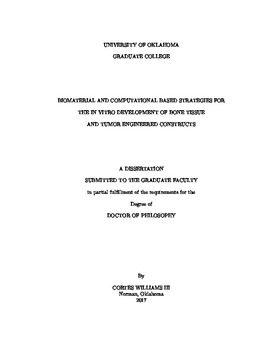| dc.description.abstract | Every year in the United States, more than 500,000 bone graft surgeries are required. In most cases, bone will regenerate after fracture with minimal complications; however, when there is a critical-sized defect or fracture healing is impaired, bone grafts must be used in order to regain proper bone function. Additionally, bone diseases such as osteoporosis, infection, skeletal defects, and bone cancer may also cause a need for bone grafts. Bone tissue engineering offers a possible solution to the supply problem plaguing current bone graft therapies by providing a near limitless supply of bone for reimplantation. Furthermore, because tissue engineered bone would be made using the patient's own cells, risk of immune rejection would be eliminated. Unfortunately, current bone culture techniques suffer from one or more of the following: 1) inadequate cell adhesion to the underlying scaffold; 2) poor or lack of proper quality control and repeatability; or 3) requiring destructive methods to judge construct quality.
During the last decade, the number and effectiveness of in vitro cancer models has increased dramatically. Utilizing a variety of techniques for 3D culture, researchers have created models that more closely resemble and predict in vitro tumor drug responses; however, the same hindrances faced in bone tissue engineering occur with some in vitro cancer models. In particular, these in vitro models consistently exhibit poor cell proliferation and distribution, which severely limits their predictive capabilities. The number one hurdle that must be overcome is the poor adhesion that cancer cells have to non hydrogel scaffolds, which severely limits the development of tumor models that contain fully developed tissue.
These aforementioned issues highlight three major questions that will be investigated in this manuscript: 1) How can we improve both mesenchymal stem cell and cancer cell adherence to the scaffolds? 2) In terms of flow-induced stresses, what is the viability of 3D printing for manufacturing repeatable scaffold architectures? 3) Do the shear stresses within a bone tissue engineered construct change over the culture period? These questions will be answered using a combination of both biomimetic scaffold functionalization and computational fluid dynamic simulations. For the former, a physical entrapment technique which introduces free amine groups to the surface of the scaffolds was developed, allowing for the subsequent attachment of RGD and n-cadherin to aid in mesenchymal stem cell and tumor cell attachment, respectively. For the latter, constructs were imaged using micro-computed tomography, reconstructed, and imported into the computational fluid dynamic program FLUENT (ANSYS, Inc), allowing for the evaluation of the flow profiles and shear stress distributions therein. The following chapters of this manuscript will focus on each of this questions in succession, outlining the motivations and methods used to tackle each problem, and the results of our findings. | en_US |
